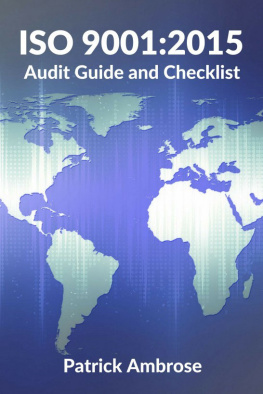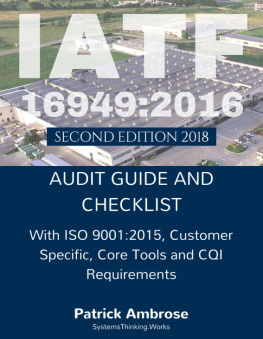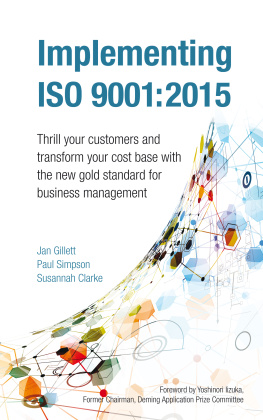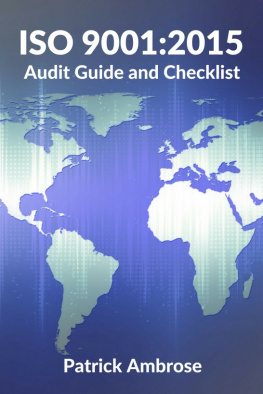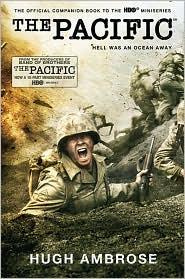Patrick Ambrose - ISO 9001:2015 Audit Guide and Checklist
Here you can read online Patrick Ambrose - ISO 9001:2015 Audit Guide and Checklist full text of the book (entire story) in english for free. Download pdf and epub, get meaning, cover and reviews about this ebook. year: 2020, genre: Romance novel. Description of the work, (preface) as well as reviews are available. Best literature library LitArk.com created for fans of good reading and offers a wide selection of genres:
Romance novel
Science fiction
Adventure
Detective
Science
History
Home and family
Prose
Art
Politics
Computer
Non-fiction
Religion
Business
Children
Humor
Choose a favorite category and find really read worthwhile books. Enjoy immersion in the world of imagination, feel the emotions of the characters or learn something new for yourself, make an fascinating discovery.
- Book:ISO 9001:2015 Audit Guide and Checklist
- Author:
- Genre:
- Year:2020
- Rating:5 / 5
- Favourites:Add to favourites
- Your mark:
- 100
- 1
- 2
- 3
- 4
- 5
ISO 9001:2015 Audit Guide and Checklist: summary, description and annotation
We offer to read an annotation, description, summary or preface (depends on what the author of the book "ISO 9001:2015 Audit Guide and Checklist" wrote himself). If you haven't found the necessary information about the book — write in the comments, we will try to find it.
ISO 9001:2015 Audit Guide and Checklist — read online for free the complete book (whole text) full work
Below is the text of the book, divided by pages. System saving the place of the last page read, allows you to conveniently read the book "ISO 9001:2015 Audit Guide and Checklist" online for free, without having to search again every time where you left off. Put a bookmark, and you can go to the page where you finished reading at any time.
Font size:
Interval:
Bookmark:


Copyright 2016
Patrick Ambrose
Published by SystemsThinking.Works
Distributed by Smashwords
Second Edition
January 2016
This publication is protected by Copyright Law, with all rights reserved. No part of this publication may be stored in a retrieval system, transmitted or reproduced in any way, including but not limited to photocopy, photograph, magnetic or other record, without the prior agreement and written permission of the author at systemsthinking.works.
Visit
https://systemsthinking.works
to learn more
This ebook may not be re-sold or given away to other people. If you would like to share this book with another person, please purchase an additional copy for each recipient. If youre reading this book and did not purchase it, or it was not purchased for your use only, then please return to your favorite ebook retailer and purchase your own copy. Thank you for respecting copyright.
Table of Contents
Forward
Creation of this new guidebook and checklist was a result of many, many discussions with internal auditors, would be internal auditors and those responsible for the outcomes and value of internal audits. A common problem was the conflict between a desire to do process audits that are not driven by meaningless checklist questions, and the needs of auditors who often spend only a very small fraction of their time doing management system audits. It seemed that there was no getting away from some kind of resource that auditors could use to help them through their audits. Yet checklists had proven to be non-value added. The result is this book. The questions listed in this book are by definition a checklist, however the intent is that the questions will be used by the auditor, not asked of the auditee. The questions are those that the auditor must answer through the process of finding evidence. Then, based on the evidence they must determine the effectiveness of the system being audited. Many of the questions listed are ones that can be answered through observation. Many will be answered in conjunction with other information gathered during the audit. Other questions ask the auditor to make a value judgment. In this way it is hoped that auditors will have a guide, while enabling them to use a process approach when auditing. This book could not have been written without help, and I received a great deal of help from some very special people. My wife Patricia was my editor, proof reader, cheerleader and motivator. Without her constant support, I probably would not have finished this book. And, my son Devon reviewed it and did nearly all of the editing and software work. Devon is also knowledgeable and experienced in auditing management systems. He has a very sharp mind and I respect and appreciate his opinions.
And finally I would like to thank you, the user of this book. I sincerely hope you will use this book to provide your management with the information to achieve their goals and objectives, to effectively satisfy their customers expectations, and to provide their employees with a stable, interesting and exciting place to work.
Sincerely
Pat Ambrose
INTRODUCTION
There is an important consideration to make before choosing to use the checklist included in this Guidebook. You should carefully determine your objective with regard to your ISO 9001 Quality Management System. If what you are looking for is the easiest way to get ISO 9001 registered, or if your aim is to do the very minimum needed for conformance, this IS NOT the checklist for you. Every question included in this checklist is designed to promote best practice. The checklist is designed to provide value to organizations that have a desire to get their moneys worth and more out of their systems. The questions strive to provide a value added effective and efficient quality management system. This checklist will help your organization to satisfy your customers, provide added value to your customers and provide value to your stakeholders but at no time does it dwell on the minimum. The interpretations of the requirements and the questions it drives are designed at all times to help create a value added system. Certainly you have the right and I would expect that you will skip questions that you believe, have no value to your organization. I would also expect that you may modify questions or even add additional questions of your own. I welcome your participation in this. In addition to audit questions, this checklist provides guidance for auditors during the process. AP or (Audit Process) notes provide valuable direction as to how and when to take note of specific data that will become important further on in the audit. These notes are the result of many years of best practice audit experience. Also within the checklist are BP (Best Practice) questions which are there to help organizations that want all of the value possible from their systems. As you can see, this is not just an audit checklist. It was designed from the beginning to promote a high value, effective and efficient management system.
1.0 AN INTRODUCTION TO ISO 9001:2015
With this new International Standard, some of the clause structure and terminology in ISO 9001:2008, have been changed to improve alignment with other management systems standards.
Basic Changes
The adoption of the HLS ( standardized High Level Structure)
An explicit requirement for risk-based thinking to support and improve the understanding and application of the process approach.
Fewer prescribed requirements.
Less emphasis on documents.
Improved applicability for services.
A requirement to define the boundaries of the QMS.
Increased emphasis on organizational context. (Link between customer expectations, organizational objectives, the Quality Policy, process objectives and process measurement)
Increased leadership requirements. (Active Participation)
Greater emphasis on achieving desired outcomes to improve customer satisfaction. (Performance Measurement)
Major differences in terminology between ISO 9001:2008 and ISO 9001:2015
Products from 2008 has become Products and services. Exclusions are No longer used in 2015. Documentation, Records is now Documented Information. Work Environment has morphed into Environment for the operation of processes. Purchased Product is now externally provided products or services. Suppliers are now External Providers and Preventive Action is gone.
It is important to recognize that the changes in the structure and terminology do not need to be reflected in the documentation of an organizations quality management system. As in the 2008 version of the ISO 9001 standard, the structure of clauses is intended to provide a coherent presentation of requirements rather than a model for documenting an organizations QMS (Quality Management System). There is no requirement and no intention for the structure of an organization's quality management system documentation to mirror that of this International Standard.
There is also no requirement for the terms used in an organizations QMS to be replaced by the terms used in this International Standard. Organizations can choose to use terms which suit their operations. For example:
ISO 9001; 2015 could be
external providersupplier, 'partner or vendor
Management Review Monthly Operations Meeting
NonconformanceITBF Issue To Be Fixed
Font size:
Interval:
Bookmark:
Similar books «ISO 9001:2015 Audit Guide and Checklist»
Look at similar books to ISO 9001:2015 Audit Guide and Checklist. We have selected literature similar in name and meaning in the hope of providing readers with more options to find new, interesting, not yet read works.
Discussion, reviews of the book ISO 9001:2015 Audit Guide and Checklist and just readers' own opinions. Leave your comments, write what you think about the work, its meaning or the main characters. Specify what exactly you liked and what you didn't like, and why you think so.

